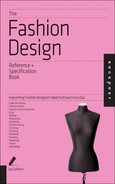
Book
ge:70
Job:12-29742 Title:RP-Fashion Design Ref and Spec Book
#175 Dtp:204 Page:71
064-071_30034.indd 71 2/27/13 4:13 PM
(Text)
Mood Boards and Library 7 1
n,
s
al
s
e
-
n
n
the final scene in North by Northwest (1959), a kiss cuts to a shot of a train entering a tunnel.
Fashion history is replete with cases of turning what seems like a compromise into an oppor-
tunity, another challenge. The hemlines of the 1920s have been stereotyped as scandalous
because they landed above the knee. That length lasted for only two years. Yet designers had
geared up to the short-lived trend with long sheer skirts over shorter linings, uneven, asym-
metrical, scalloped, and handkerchief hems, which exposed the knees through movement.
How can contemporary designers speak to the age they live in and still push the envelope?
Think Tank
One of the most powerful questions designers can ask of themselves or their team is, What
if? This is a trigger for free association that can churn up some great ideas. Brainstorming
sessions can be exciting opportunities for exploring ideas, no matter how fanciful. Not every
idea that comes out of these discussions will be a gem. So it is important not to weigh down
the process with the expectation of a specific result. Some of the best brainstorming ses-
sions will serve as a spark for bigger, better, and broader outcomes. A designer might want
to assemble, either formally or informally, a group of people who have a track record of being
able to think out loud. The group should represent an assortment of strengths: good judges of
behavior, skilled wordsmiths, talented visual artists, and, of course, the business minded.
This process is not the same as making decisions by committee, where each opinion must be
factored into the result and which, more often than not, produces watered-down concepts. A
little dissent among members of the group who don’t agree with the direction or don’t see its
potential can really help force others to hone their vision as well as their delivery. Someone
should always be at the helm to help facilitate a productive and safe environment for these
meetings of the mind and to make the final call. If a designer is lucky, the last question will
come in the shape of a challenge to choose from many good ideas.
This collaborative effort of gathering information can also be seen in the design room as part
of the fitting process of a sample garment. A designer will work with the patternmaker and
the stitcher to fine-tune the math and the sewing techniques, affecting the overall look. Even
the cutter can contribute by making suggestions that will influence the design and fit and will
affect the cost of the garment. Designers should also ask for feedback from the fit model, to
ensure that their experience of the garment achieves what was intended.
Casting a wider net by bringing in objective parties that represent the target customer will fur-
nish more data. This method of testing prototypes is called a focus group. The term conjures
up images of people behind two-way mirrors giving their opinions about cereal. Although this
kind of testing still takes place, it is not as fruitfully applied to fashion. Researchers now re-
move the focus group from sterile environments, bringing the model right to the public in the
form of experience stations. The product gets into the hands of end-users where they can be
observed in a less clinical way.
05
Book
ge:70
Job:12-29742 Title:RP-Fashion Design Ref and Spec Book
#175 Dtp:204 Page:71
064-071_30034.indd 71 2/27/13 4:12 PM
..................Content has been hidden....................
You can't read the all page of ebook, please click here login for view all page.
